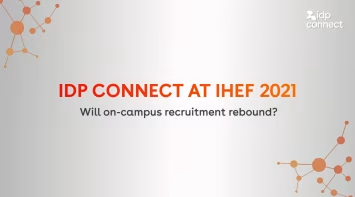I truly believe we’re not meant to go through life alone. It would be such a waste not to be engaged in community with others, to learn, to grow, and ultimately, to thrive. These days, for international offices, you’d be hard pressed to find any takers for a solo strategy for recruitment, admissions and enrollment of overseas students. While the world has gotten a lot smaller in terms of connectivity, it’s still an enormous place with nearly 8 billion people and 190+ countries and territories to comprehend. To reach this world in a focused, efficient way requires choosing not only the right platforms, as we discussed last month, but also the right partnerships.

Image courtesy of Learning Disabilities Association of America
Linking Your Purpose to Your Partnerships
When we began this series, our initial focus was to identify the purpose behind your institution’s strategic international enrollment management (SIEM) as embodied by your internal and external perspective on the global playing field and your willingness to engage in data-driven, long-term planning. Those purposeful exercises lay the foundation for what should guide your decision-making in picking partners that can best help you get where you need to be.
What should be clear is no one partner or formula for choosing partnerships will be universally applicable to all institutions. In most cases, a healthy mix of providers on and off campus can make all the difference and spread the responsibilities among those committed to your shared cause. Certainly, in the last year, we realized we all need impactful partners to move the needle toward your goals for international student enrollment. For example, the issue of how to recruit when travel is not possible raises all sorts of challenges, but highlights the need for having partners to facilitate connections.
Choosing Your External Partners Wisely
In our personal lives, we can all relate to both extremely valuable friendships that produce much fruit and relationships where we’ve had regrets. Partnerships in international education are no different. Even with the best of partners, there will be ups and downs. Some start strong but fade quickly, while others overpromise and underdeliver. Numerous factors will ultimately impact your selection including your budget, internal bandwidth, and your need for balance (i.e., not putting all your recruitment relationship eggs in one basket). Of course, hearing from others that have worked with these external partners is a must.
In your choice of partners, there are governmental outlets like the U.S. Department of State’s EducationUSA network, U.S. Commercial Service (Commerce Department), as well as DC embassies of countries with government scholarship programs. Educational agencies and service providers (like IDP Connect) can provide you with a wide range of tools to get direct access to students at various stages in the recruitment process. Various secondary school counselor networks can help you develop relationships and nurture potential feeder schools. Your current and future overseas university partners can not only be a source of exchange students, but can also turn into extremely strong and diverse pipelines for future students and academic collaboration between institutions, if developed properly. . Lastly, if there is a state international education consortium where you are, e.g. Study Texas, Study New York, or Study Michigan, there is, most definitely, strength in numbers when it comes to student recruitment.
Embracing On-Campus Allies
Regardless of which external partners you choose to work with, none of it matters if you have not built the case for a full life-cycle approach to the international student experience, from prospect to alumni, with your campus community. I offer three tips in developing your relationships with on-campus partners:
Make the case to senior administration to keep them engaged.
Collaborate among key offices that are high touch with international students.
Coordinate communications with these offices during the student journey.
I cannot emphasize enough how critical support from senior administration officials at your institution is to the success of long-term SIEM efforts on campus. Managing those relationships up the chain of command, keeping them engaged on key external factors impacting your work, and ensuring they are aware of what issues international students are facing throughout their journey is no easy feat, but must be done.
On most campuses, the initial relationships among international admissions, an ESL program, and the ISSS office in the transition from admitted to enrolled students (initial I-20s, pre-departure, arrival and orientation touchpoints) receive the bulk of attention. The reality is, the international student journey is far more extensive than that. All of those (hopefully) positive, early interactions can be erased in an instant by bad experiences your students have with financial aid, student employment and/or residence life/housing once they get settled on campus. Even for the institutions doing a good job on these initial and ongoing international student experiences, outcomes matter in the end. Survey data from several outlets, at least before the pandemic, shared how significant career outcomes were for prospective international students (and their parents) while choosing their destination countries and institutions. So, I ask you, how well does your career services or professional development office cater to the very specific needs of international students? Is there data available on job placement rates or starting salaries for international students graduating with different academic degrees? Does your alumni office track what happens to international graduates?
There are ample opportunities to work together to improve your processes, communications and cross-cultural training across campus. Clearly, this responsibility is not yours alone. With the right support from campus partners, you can kick-start this process.
Next month, we’ll start the final third of the 6 P’s series with a focus on personalization.
You might like...

Q&A with James Smurthwaite: Getting prospective students excited about studying abroad
In this series of interviews we get to know some of our IDP experts who often operate behind the scenes.

Q&A with Rachel MacSween, Director of Client Partnerships UK and Europe at IDP Connect
In our latest Q&A, Rachel talks all things HE and why the sector continues to inspire her

Counsellor Q&A: Thai perspectives on studying in the UK and attracting more Thai students to UK institutions
Specialist advice from our education counsellors for the Thai student market



